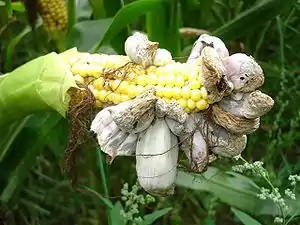Ustilaginomycetes
Die Ustilaginomycetes sind eine Gruppe der Brandpilze (Ustilaginomycotina). Alle Vertreter sind Parasiten an Blütenpflanzen.
| Ustilaginomycetes | ||||||||||||
|---|---|---|---|---|---|---|---|---|---|---|---|---|

Maisbeulenbrand (Ustilago maydis) | ||||||||||||
| Systematik | ||||||||||||
| ||||||||||||
| Wissenschaftlicher Name | ||||||||||||
| Ustilaginomycetes | ||||||||||||
| R.Bauer, Oberw. & Vánky |
Merkmale und Lebensweise
Die Ustilaginomycetes sind dimorphisch, bilden also abwechselnd hefenartige und Myzel-Stadien. Sie bilden Teliosporen und schleudern ihre Basidiosporen nicht weg.
Die Ustilaginomycetes leben parasitisch auf Bedecktsamern, vorwiegend Vertretern der Süß- und Sauergräser. Die Interaktionszone mit dem Wirt ist groß.
Systematik
Die Ustilaginomycetes bilden als monophyletische Gruppe eine der beiden Klassen der Brandpilze. Die Ustilaginomycetes selbst werden in zwei Ordnungen unterteilt:[1]
- Ordnung Urocystales, bilden vorwiegend Holobasidien
- Ordnung Brandpilzartige (Ustilaginales), bilden vorwiegend Phragmobasidien
Die Familie Glomosporiaceae kann noch keiner Ordnung zugeordnet werden.
Belege
- Dominik Begerow, Matthias Stoll, Robert Bauer: A phylogenetic hypothesis of Ustilaginomycotina based on multiple gene analyses and morphological data. Mycologia, Band 98, 2006, S. 906–916. doi:10.3852/mycologia.98.6.906
Einzelnachweise
- DS Hibbett und 66 weitere Autoren: A higher-level phylogenetic classification of the Fungi. Mycological research, Band 111, 2007, S. 509–547. PMID 17572334 (PDF; 1,3 MB)
Weblinks
Commons: Ustilaginomycetes – Sammlung von Bildern, Videos und Audiodateien
This article is issued from Wikipedia. The text is licensed under Creative Commons - Attribution - Sharealike. The authors of the article are listed here. Additional terms may apply for the media files, click on images to show image meta data.